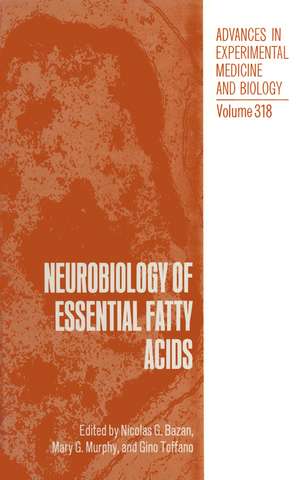Neurobiology of Essential Fatty Acids: Advances in Experimental Medicine and Biology, cartea 318
Editat de Nicolas G. Bazan, Mary G. Murphy, Gino Toffanoen Limba Engleză Paperback – 29 oct 2012
Din seria Advances in Experimental Medicine and Biology
- 9%
 Preț: 719.56 lei
Preț: 719.56 lei - 5%
 Preț: 717.00 lei
Preț: 717.00 lei - 5%
 Preț: 717.00 lei
Preț: 717.00 lei - 15%
 Preț: 640.24 lei
Preț: 640.24 lei - 5%
 Preț: 715.71 lei
Preț: 715.71 lei - 5%
 Preț: 716.28 lei
Preț: 716.28 lei - 20%
 Preț: 691.93 lei
Preț: 691.93 lei - 5%
 Preț: 1031.00 lei
Preț: 1031.00 lei - 5%
 Preț: 820.42 lei
Preț: 820.42 lei - 5%
 Preț: 716.28 lei
Preț: 716.28 lei - 15%
 Preț: 641.38 lei
Preț: 641.38 lei - 5%
 Preț: 717.20 lei
Preț: 717.20 lei - 5%
 Preț: 715.35 lei
Preț: 715.35 lei - 5%
 Preț: 1113.83 lei
Preț: 1113.83 lei - 20%
 Preț: 1161.71 lei
Preț: 1161.71 lei - 5%
 Preț: 1170.51 lei
Preț: 1170.51 lei - 18%
 Preț: 1119.87 lei
Preț: 1119.87 lei - 5%
 Preț: 1288.48 lei
Preț: 1288.48 lei - 5%
 Preț: 1164.67 lei
Preț: 1164.67 lei - 5%
 Preț: 1101.73 lei
Preț: 1101.73 lei - 18%
 Preț: 1123.67 lei
Preț: 1123.67 lei - 5%
 Preț: 1435.64 lei
Preț: 1435.64 lei - 20%
 Preț: 1044.10 lei
Preț: 1044.10 lei - 18%
 Preț: 946.39 lei
Preț: 946.39 lei - 5%
 Preț: 292.57 lei
Preț: 292.57 lei - 18%
 Preț: 957.62 lei
Preț: 957.62 lei - 18%
 Preț: 1235.76 lei
Preț: 1235.76 lei - 5%
 Preț: 1231.55 lei
Preț: 1231.55 lei - 5%
 Preț: 1292.30 lei
Preț: 1292.30 lei - 5%
 Preț: 1102.10 lei
Preț: 1102.10 lei - 18%
 Preț: 1132.81 lei
Preț: 1132.81 lei - 5%
 Preț: 1165.19 lei
Preț: 1165.19 lei - 5%
 Preț: 1418.48 lei
Preț: 1418.48 lei - 5%
 Preț: 1305.63 lei
Preț: 1305.63 lei - 18%
 Preț: 1417.72 lei
Preț: 1417.72 lei - 18%
 Preț: 1412.99 lei
Preț: 1412.99 lei - 24%
 Preț: 806.15 lei
Preț: 806.15 lei - 18%
 Preț: 1243.29 lei
Preț: 1243.29 lei - 5%
 Preț: 1429.44 lei
Preț: 1429.44 lei - 5%
 Preț: 1618.70 lei
Preț: 1618.70 lei - 5%
 Preț: 1305.12 lei
Preț: 1305.12 lei - 18%
 Preț: 1124.92 lei
Preț: 1124.92 lei - 5%
 Preț: 1097.54 lei
Preț: 1097.54 lei - 15%
 Preț: 649.87 lei
Preț: 649.87 lei - 5%
 Preț: 1097.54 lei
Preț: 1097.54 lei - 18%
 Preț: 945.79 lei
Preț: 945.79 lei - 5%
 Preț: 1123.13 lei
Preț: 1123.13 lei - 20%
 Preț: 816.43 lei
Preț: 816.43 lei
Preț: 369.72 lei
Preț vechi: 389.17 lei
-5% Nou
Puncte Express: 555
Preț estimativ în valută:
70.74€ • 74.06$ • 58.54£
70.74€ • 74.06$ • 58.54£
Carte tipărită la comandă
Livrare economică 01-07 aprilie
Preluare comenzi: 021 569.72.76
Specificații
ISBN-13: 9781461365150
ISBN-10: 1461365155
Pagini: 460
Ilustrații: XI, 444 p.
Dimensiuni: 156 x 244 x 24 mm
Ediția:Softcover reprint of the original 1st ed. 1992
Editura: Springer Us
Colecția Springer
Seria Advances in Experimental Medicine and Biology
Locul publicării:New York, NY, United States
ISBN-10: 1461365155
Pagini: 460
Ilustrații: XI, 444 p.
Dimensiuni: 156 x 244 x 24 mm
Ediția:Softcover reprint of the original 1st ed. 1992
Editura: Springer Us
Colecția Springer
Seria Advances in Experimental Medicine and Biology
Locul publicării:New York, NY, United States
Public țintă
ResearchCuprins
Phospholipases A2: Properties And Modulation.- The Induction of Cellular Group II Phospholipase A2 By Cytokines And Its Prevention By Dexamethasone.- Brain Phospholipases and Their Role In Signal Transduction.- Characteristics And Possible Functions of Mast Cell Phospholipases A2.- Extracellular Phospholipase A2.- Ischemic Brain Damage: Focus on Lipids and Lipid Mediators.- Cell Signaling and Essential Fatty Acids: Cross-Talk Between Receptors And Messengers.- Reciprocal Regulation of Fatty Acid Release In The Brain by Gaba And Glutamate.- Nmda Receptor-Mediated Arachidonic Acid Release In Neurons: Role In Signal Transduction and Pathological Aspects.- Non-Eicosanoid Functions of Essential Fatty Acids: Regulation of Adenosine-Related Functions In Cultured Neuroblastoma Cells.- Contributions To Arachidonic Acid Release In Mouse Cerebrum By The Phosphoinositide-Phospholipase C And Phospholipase A2 Pathways.- Modulation of Arachidonic Acid Metabolism In Cultured Rat Astroglial Cells by long-chain n-3 fatty acids.- Modulation Of Glutamate Release From Hippocampal Mossy Fiber Nerve Endings By Arachidonic Acid And Eicosanoids.- Metabotropic Glutamate Receptors And Neuronal Toxicity.- Metabolites Of Essential Fatty Acids And Other Membrane-Derived Second Messengers In Cell Signaling.- A role for the arachidonic acid cascade in fast synaptic modulation: ion channels and Transmitter uptake systems as target proteins.- Aplysia californica contains a novel 12-lipoxygenase which generates biologically active products From arachidonic acid.- Essential fatty acid deficiency in cultured sk-n-sh Human neuroblastoma cells.- Phospholipid Metabolism And Second Messenger System After Brain Ischemia.- Dietary Supply Of Essential Fatty Acids, Synaptogenesis, and Photoreceptor Membrane Biogenesis.- Impact of dietary fatty acid balance on membrane Structure and function of neural tissues.- Structural and Functional Importance of Dietary Polyunsaturated Fatty Acids In The Nervous System.- Long and very long polyunsaturated fatty acids of retina and spermatozoa: The whole Complement of polyenoic fatty acid series.- Phospholipid Metabolism In Rat Intestinal Mucosa After Oral Administration of Lysophospholipids.- Carbachol-Stimulated Release of Arachidonic Acid and Eicosanoids From Brain Cortex Synaptoneurosome Lipids of Adult and Aged Rats.- Carbachol-Induced Stimulation Of Inositol Phosphates, Arachidonic Acid and Prostaglandin F2?In Rabbit Retina.- Induced and Spontaneous Seizures In Man Produce Increases In Regional Brain Lipid Detected by In Vivo Proton Magnetic Resonance Spectroscopy.- Network of Signal Transduction Pathways Involving Lipids: Protein Kinase C-Dependent And -Independent Pathways.- Essential Fatty Acids, Excitable Membrane Phospholipids, And Pathophysiology.- Conservation of Docosahexaenoic Acid In The Retina.- Docosahexaenoic Acid Uptake and Metabolism In Photoreceptors: Retinal Conservation By An Efficient Retinal Pigment Epithelial cell-mediated recycling process.- Essential Fatty Acids and Neurodevelopmental Disorder.- Regulation of Arachidonic Acid Metabolism In The Perinatal Brain During Development And Under Ischemic Stress.- Interactions of Phospholipids And Free Fatty Acids With Antidepressant Recognition Binding Sites In Rat Brain.- Very long-chain Fatty Acids in Peroxisomal Disease.- Long Chain Omega 3 Polyunsaturates In Formula-Fed Term Infants.- Severe Changes In Polyunsaturated Fatty Acids In The Brain, Liver, Kidney, and Retina In Patients With Peroxisomal Disorders.- Degradation of Phospholipids And Protein Kinase CActivation For The Control Of Neuronal Functions.- Essential Fatty Acids and Excitable Membrane Phospholipids.- Disposition Kinetics of Phospholipid Liposomes.- Behavioral And Morpho-Functional Correlates of Brain Aging: A Preclinical Study With Phosphatidylserine.- Receptor Coupling To Phosphoinositide Signals.- Diacylglycerol Composition And Metabolism In Peripheral Nerve.- Contributors.













